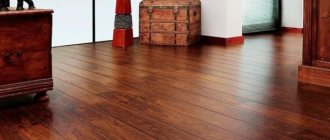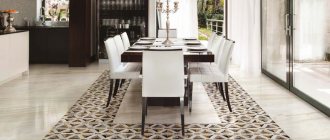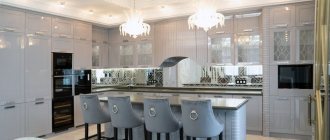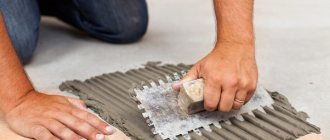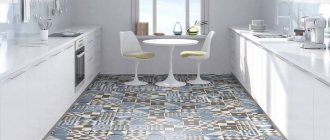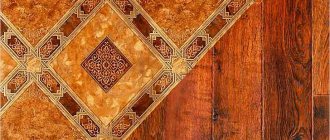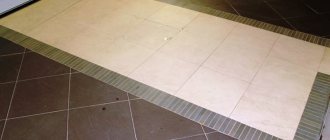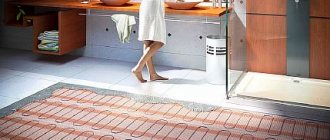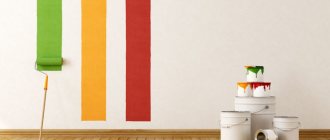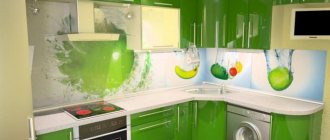The key to a successful renovation is not only the use of beautiful materials, but also the durability and ease of use of the finished work. It is especially important to maintain a certain balance between beauty and functionality when performing kitchen renovation work. Odors, greasy splashes, and pieces of food falling on the floor can easily ruin an impractical coating. Therefore, people often try to figure out the question in advance: what is better in the kitchen - tiles or laminate? How to choose a flooring so that it is reliable and pleasing to the eye? Read more below.
What is better in the kitchen - tiles or laminate?
Which is better - laminate or tile?
Before making final conclusions, you should understand the conditions under which the floor covering will be used. This is very important and will help you understand why you shouldn’t lay, say, carpet in the kitchen, but rather replace it with some kind of easy-to-clean covering.
Kitchen flooring
Features of the premises and evaluation criteria
Under what conditions will the flooring be used? Perhaps, it is the factors that will influence it that are the most significant when choosing a finishing material. So, the cuisine is different:
- high humidity levels . There is no escape from moisture in the kitchen - it is present both when washing dishes and during cooking in large quantities. Also, hot/cold water may be repeatedly spilled on the floors;
- significant temperature changes . If the kitchen is actively cooking and the stove is running, the air temperature will easily rise to +30 degrees or more. If you open the window for ventilation, the temperature quickly drops to +5-10 degrees in the floor area.
- high cross-country ability . The kitchen is a room in which a person appears quite a large number of times during the day. At the same time, the kitchen is often not only a place for preparing food, but also a dining room.
Determining flooring requirements
The choice of flooring will largely depend on these factors. Only the right material will be easy to use and look very beautiful.
Ceramic tiles on the kitchen floor
Flooring requirements
It remains to understand what the floor covering should be so that, under the conditions described above, it can serve for many years without losing its decorative qualities. So, the material for finishing the floor should not just be beautiful - it is desirable that it be somewhat pliable, not too hard . In some cases, this will help save dropped dishes from damage. And the floor itself will be more intact in case of falling dishes and heavy objects.
What should the floor be like in the kitchen?
It is also advisable that the floors are not too cold . If the material has low thermal conductivity, this can be achieved even without a floor heating system.
Choosing the right flooring for the kitchen
On a note! The material itself will not heat up in any case. But it is well known that walking on tiles is much less pleasant because of the feeling of cold than on linoleum, wood or carpet.
Laminate for the kitchen
The coating may have high levels of noise and heat insulation , but this is not necessary.
The main thing is that the coating is easy to wash and free from grease and stains of various origins. It is important to remember that the kitchen should not have any covering with lint, otherwise it will be extremely difficult to clean it.
Carpet
Place 15 square meters in a room. m: from 855 RUR.
Carpet is usually laid in a nursery or bedroom. Soft carpet is pleasant to walk on, absorbs noise and is easy to install. You don’t need any special care either—a vacuum cleaner can handle crumbs and dust.
R per square meter" loading="lazy" data-bordered="true">
However, carpet cannot be knocked out like a small rug, so dust in the fibers can live for years - this option is definitely not suitable for allergy sufferers. It is also better not to lay carpet near bathrooms to avoid mold.
Comparison of laminate and tiles
The most popular types of flooring used in the kitchen are laminate, linoleum, tile and vinyl. And if linoleum is now purchased less and less often, then other types of coating compete sharply with each other. Each of them has its own advantages and disadvantages, knowing which you can make the right choice.
What is better in the kitchen - laminate or tile?
Linoleum
Place 15 square meters in a room. m: from 2500 RUR.
Most often, linoleum is placed in the kitchen or in the hallway - this is one of the cheapest flooring options.
Linoleum can be natural, PVC, alkyd, rubber, colloxylin. For residential premises, it is better to use the first two: natural linoleum is environmentally friendly, but expensive, PVC is cheaper, but not so flexible.
Natural linoleum is made from natural ingredients: jute fiber, linseed oil, natural resins, cork, limestone.
Linoleum comes in different wear resistance classes. The purpose of the room depends on which class is suitable: in the bedroom you can put linoleum of the 21-23rd class, and for residential premises with medium and high traffic - for example, a child's room - 31-34th class.
Laminate in your kitchen - pros and cons
Laminate was previously considered almost an elite type of flooring, but over time it became available to the majority of the population with average earnings. At the same time, the material costs much less than a coating made from solid natural wood, but it looks no worse - its decorative qualities can be rated a solid five.
Laminate flooring in the kitchen - photo
Expert opinion
Afanasyev E.V.
Chief editor of the pol-exp.com project Engineer.
Laminate is a layered material that is made from wood-fiber boards that have an outer decorative and protective layer. In this case, the layer that gives the appearance of the lamellas is usually paper with a pattern applied to it, covered with a protective layer of acrylic or melamine.
Laminate structure
On a note! Laminate can perfectly imitate not only wood, but also tiles, marble, and have a single color. Sometimes it is extremely difficult to distinguish a “fake” from the original by eye.
Laminate marking
Advantages of laminate allowing it to be used in the kitchen:
- weak reaction to various chemicals;
- excellent resistance to ultraviolet radiation;
- ease of care;
- Easy to clean - just wipe the coating with a damp cloth;
- the material does not seem cold when walking barefoot and retains heat for a long time;
- high levels of noise insulation;
- plasticity and elasticity.
Light laminate in the kitchen interior
Disadvantages of laminate that limit its use in the kitchen:
- tendency to mechanical damage caused by sharp objects - dents and scratches may remain on the coating, which can lead to moisture getting inside the material;
- laminate is afraid of water and if it gets under the protective layer (at the joints or in places where the lamellas are damaged) it swells, bulges, and loses its appearance. To avoid this, it is necessary to carry out the installation correctly, and also protect the end parts of the lamellas from moisture - this is the weakest point of the coating;
- in the event of a flood, the floors will be hopelessly damaged.
Scratch on laminate
Advice! To reduce the risk of rapid wear of the material, you need to make your choice responsibly and purchase high-quality, high-quality coating. Also, many aspects will depend on the quality of installation.
Variety of laminate types
You will find detailed step-by-step instructions for laying laminate flooring in the article . ” We talk about the nuances, choosing a substrate and its types, the installation process and how to cut holes.
Tiles in the kitchen - advantages and disadvantages
Ceramic tiles are a coating that is considered, perhaps, the standard for finishing a kitchen or bathroom, that is, places where there is a high level of humidity. But still, it occurs much more often in the bathroom.
Ceramic floor tiles
Advantages of ceramic floor tiles in the kitchen:
- high wear resistance - tiles can easily serve for decades if installed correctly;
- excellent resistance to moisture;
Ceramic tile
On a note! If the floor is completely covered with tiles, and the seams between the individual elements are sealed properly, then the tiles will not allow water to seep into the neighbors below in the event of a flood.
Cersanit Dublin. Floor tile
- resistance to mechanical damage as a result of falling knives;
- a lot of color variations;
- environmentally friendly material that does not harm human health;
- resistance to chemicals, inertness;
- the material does not burn and does not conduct electricity;
- Finally, the tiles are easy to care for - just wipe it off.
Floor tiles Imola Forest
Disadvantages of ceramic floor tiles in the kitchen:
- If installed incorrectly, it may peel off or break;
- may break if something heavy is dropped (provided that voids have formed under the tiles during installation. To avoid this, the adhesive is applied in one continuous layer, and not in “slaps”);
- depending on the texture, it can be very slippery;
- more difficult to install compared to laminate;
- due to temperature fluctuations and poor glue, it may peel off from the screed;
- dishes that fall on the floor break, because the tiles are very hard;
- The tiled floor is cold and has low sound insulation.
Ceramic tiles for kitchen finishing
It is almost impossible to cope with the shortcomings of a tiled coating. Unless you can warm it up using a heated floor system. Ceramic tiles are difficult to transport and install, and are also quite expensive.
When purchasing tiles, it is recommended to take them with some reserve, since the shade of the same tile may differ in different batches. Find a calculator for calculating the number of tiles to decorate a room in a special article.
Recommendations for choosing coatings for an apartment
The choice is obvious. In regions with warm climates, ceramic tiles are chosen. This floor will add natural coolness on hot days. Wood lovers prefer the classic colors of laminated panels: rustic oak, clear oak, dark walnut or wild cherry.
Porcelain tiles in the bathroom are suitable if the floor is not very level. Although vinyl floor tiles in an apartment look good, class 32 laminated boards are chosen for an apartment with low traffic and a minimal budget.
What to choose for the kitchen - tiles or laminate? We take a scientific approach
Each floor covering has its own advantages and disadvantages, which we found out by carefully studying the information and text about them above. A summary table will help you in your choice, which demonstrates all the qualities that a floor covering should have, as well as the extent to which the materials are endowed with them.
Variety of vinyl floor tiles
Table. Comparison of PVC tiles, tiles and laminate.
| Characteristic | Laminate | Ceramic tiles | PVC tiles |
| Moisture resistance | Low moisture resistance, or rather lack thereof. The material is afraid of exposure to water and is deformed if it gets under or between the slats (the only exception is moisture-resistant laminate). | It has an extremely high level of moisture resistance and is absolutely not afraid of water. | Excellent moisture resistance, the material does not swell or deform when water gets on it. |
| Wear resistance | Depends on the class of material. The higher the class, the longer the material lasts. But in any case, the performance is lower than that of tiles. | Absolute, practically does not wear out over decades of use. | It has fairly high wear resistance, but it is still lower than that of ceramic tiles. May fade over time. The service life is usually about 10 years. |
| Elasticity | It depends on the thickness and characteristics of the substrate, but it is definitely higher than that of ceramic tiles. | Its complete absence. | It has a good elasticity index, quite soft material - softer than laminate. |
| Comfortable operation | The material is pleasant to the feet, you can walk barefoot. It won't feel cold at any time of the year. Excellent thermal insulation performance. | In winter it is very cold, walking barefoot is not comfortable. Installation of a heated floor system is required. | It has good sound insulation and is more pleasant to walk on than on tiles. In this respect it resembles linoleum. |
| Slip | Depends on the texture of the surface, but, as a rule, the material is not slippery. | Depending on the texture, it can be slippery or, conversely, rough. | Slips no more than laminate. |
| Difficulty of installation | Additional materials must be purchased. Installation is easier and faster than laying tiles. | The most expensive activity financially, in terms of time and effort. Even during installation, you can damage the tile by dropping it. You need to purchase glue. | Installation is carried out quickly, the tiles are laid with glue, but you need to wait until the surface dries. |
| Ability to resist pollutants | The surface cleans well, but if debris or other contaminant gets between the cracks, it can only be removed after disassembling the floor. | It practically does not get dirty, and if it gets dirty, it is very easy to clean without the use of any expensive products. | The characteristics are the same as those of linoleum - pollutants are removed well. |
PVC tiles with click lock
Conclusions: preferences and trade-offs
On most points, ceramic tiles have become the undisputed leader, but the main disadvantages are so significant that they force many to abandon them and give preference to laminate or PVC tiles. At the same time, laminate, even of the highest class, will swell when the apartment is flooded. The likelihood of this happening is low, but the risk still exists.
Even a non-professional consumer can easily distinguish moisture-resistant laminate. It contains a specific green HDF board that is noticeable when the material is cut. It is this layer that is absolutely resistant to moisture and dampness, prevents the growth of fungus and bacteria due to antibacterial impregnation
The problem with tiles is the lack of comfort in the room where they are located. With laminate or PVC tiles, the kitchen will look much more attractive. But the tiles are not afraid of water. In general, you should still focus on personal preferences and budget. Laminate, of course, will cost less than ceramics.
Tiles and laminate in the kitchen
Advice! If you want to cover the kitchen floors with both laminate and tiles, then you can combine them. This combination looks very harmonious. For example, you can cover the floors near the work areas with tiles, and lay laminate where the dining table is. By the way, both types of flooring require proper installation and careful leveling of the subfloor.
How to connect laminate and tiles. Aluminum molding
Joint between tiles and laminate
Video - Which is better, laminate or tile?
Parquet board
Place 15 square meters in a room. m: from 9960 RUR.
The parquet board consists of two layers: the top layer is a valuable type of wood such as ash or oak, and the bottom layer is usually made of pine or spruce.
The parquet flooring looks expensive due to the top layer, and it also hides noise. Parquet boards are afraid of moisture: if a lot of liquid accumulates on the surface, the coating will have to be changed.
This type of flooring is easy to install, but the top layer will have to be looked after: natural wood needs to be periodically polished with varnish or wax.
P » loading=»lazy» data-bordered=»true»>
Installation of PVC tiles
PVC tiles are a cross between ceramics and laminate in terms of performance characteristics. That is why it is worth getting acquainted with the installation of this flooring.
Step 1 . All subfloors are first cleared of debris.
Step 2. Some planks will have to be cut, because the covering needs to be laid so that the joints of the two planks are offset. The tiles are cut as follows: first, the required distance is measured on one strip, equal to the length from the end of the last whole tile in the row to the wall. Markings are made, an incision is made with a stationery knife. The tile is bent along the cut line, broken and cut to the end.
The required distance is measured
PVC tiles are being cut
The tile is bent along the cut line
The product is cut through to the end
Step 3. The floor area is divided into 4 parts. Two lines are drawn perpendicular to each other through the center of the room.
Floor marking
Step 4. Next, the tiles are calibrated - laid out on the surface of the subfloor as they will be glued. You need to start from the identified center in the direction of the wall farthest from the door. You can also lay tiles starting from the far wall in rows.
Laying PVC tiles without glue
Advice! To avoid further confusion when laying tiles, it is recommended to lay out the floors according to the diagram (for beginners).
Step 5. Before you start laying tiles, close the window in the kitchen - there should be no drafts. Special adhesive for vinyl tiles is thoroughly mixed to a uniform consistency. To apply and level the glue, purchase a special notched trowel.
You will need a notched spatula for this work.
Step 6. Since the drying time of the glue is short (about 20 minutes), the glue is applied in small portions in an even thin layer and leveled.
Applying glue in small portions
The glue layer is leveled
Step 7. Next, the tile is laid strictly in one direction according to the arrows on its reverse side. It is not glued all at once, but starting from one edge. The tile is slammed down and then processed with a roller to compact it. This will remove excess air from under the tiles.
Arrow on the back of the tile
Gluing PVC tiles
Processing tiles with a roller
Step 8. Next, glue is applied again, and the next tile is laid joint to joint. The edges of the planks must be clearly aligned with each other.
The next tile is laid close to the previous one
Attention! There should be a gap of about 5-7 mm wide along the wall. It will subsequently be covered with a plinth.
In this way, vinyl tiles are laid over the entire surface. Excess adhesive from the surface can be removed with a damp cloth.
Decorative self-leveling floor
Place 15 square meters in a room. m: from 15,000 R.
Self-leveling flooring - or liquid linoleum - is obtained from the “spreading” of a self-leveling mixture over a screed. Previously, this coating was used only in warehouses, but now it is used for finishing apartments.
This coating is durable and durable: if you have to knock down the self-leveling floor, it will take more effort and time. The self-leveling floor is harmless to allergy sufferers and is easy to clean.
True, it is difficult to obtain an ideal surface on your own: first you need to level the floor so that the liquid linoleum does not repeat the bumps and depressions, and then quickly distribute the mixture - the self-leveling floor instantly hardens.
